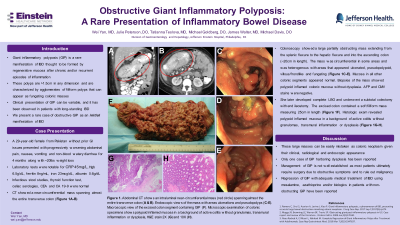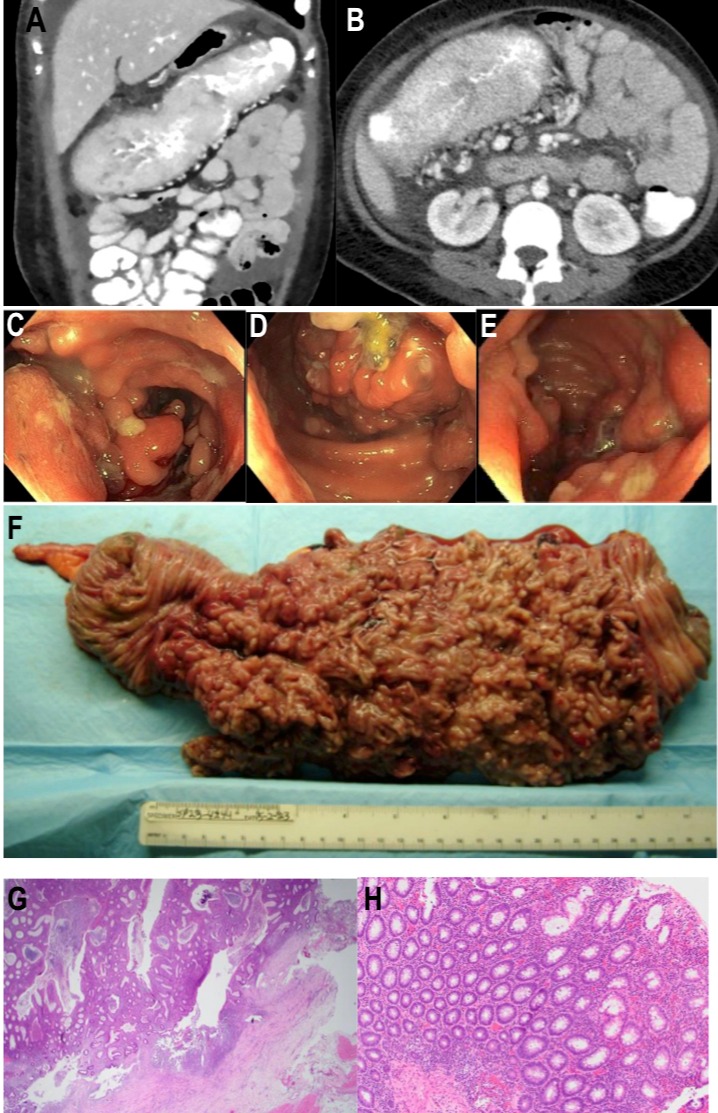Sunday Poster Session
Category: IBD
P0808 - Obstructive Giant Inflammatory Polyposis: A Rare Presentation of Inflammatory Bowel Disease
Sunday, October 22, 2023
3:30 PM - 7:00 PM PT
Location: Exhibit Hall

Has Audio
.jpg)
Wei Yan, MD
Albert Einstein Medical Center
Philadelphia, PA
Presenting Author(s)
Wei Yan, MD1, Julie Sullivan, DO2, Kirtenkumar Patel, MD3, Michael Goldberg, DO4, Tatiana Teslova, MD1, Michael Davis, DO1
1Albert Einstein Medical Center, Philadelphia, PA; 2Albert Einstein Gastroenterology Fellowship, Philadelphia, PA; 3St. Mary Medical Center, Langhorne, PA; 4Albert Einstein Gastroenterology, Philadelphia, PA
Introduction: Giant inflammatory polyposis (GIP) is a rare manifestation of inflammatory bowel disease (IBD). These polyps are >1.5cm in any dimension by definition and are characterized by agglomerates of filiform polyps that can appear as fungating masses. GIP is considered to be a benign entity, but can easily masquerade as colon cancer given their radiologic and endoscopic appearances. GIP has been observed in patients with long standing IBD. We present a case of obstructive GIP as an initial manifestation of IBD.
Case Description/Methods: A 29-year-old female with menorrhagia and iron deficiency anemia who presented with worsening abdominal pain, nausea and watery non-bloody diarrhea for 4 months. She also reported early satiety, vomiting and ~20lbs weight loss. She has no personal or family history of any GI conditions. Laboratory tests showed Hgb 6.5g/dL, ferritin 8μg/L and iron level 23μg/L, with hypoalbuminemia of 0.6g/dL and CRP of 44. Infectious stool studies, thyroid tests and celiac serologies were normal. CT images showed a large intraluminal near-circumferential mass spanning almost the entire transverse colon with pericolonic lymphadenopathy. She underwent a colonoscopy that showed a large partially obstructing mass extending from the splenic flexure to the hepatic flexure and into the ascending colon (approx. 20cm in length). The mass was circumferential in some areas and was heterogenous with areas that appeared ulcerated, pseudopolypoid and fungating. Colonic mucosa in other segments were normal. Biopsies of the mass were obtained and showed polypoid inflamed colonic mucosa with granulation tissue. AFP & CMV stains were negative.
She underwent a subtotal colectomy due to concern for complete large bowel obstruction. The excised colon contained a soft filiform mass measuring 25cm in length. Histologic exam showed polypoid inflamed colonic mucosa in a background of active colitis without granulomas, transmural inflammation or dysplasia.
Discussion: GIP is a rare manifestation of IBD thought to be formed by regenerative mucosa after chronic and/or recurrent inflammation. Patients may present with abdominal pain, anemia, diarrhea, rectal bleeding, weight loss and bowel obstruction. These large masses can be easily mistaken as colonic neoplasm given their clinical, radiological and endoscopic appearance. However, there has only been one reported case of GIP haboring dysplasia. The management of GIP is not well established as most patients ultimately require surgery for obstructive symptoms.

Disclosures:
Wei Yan, MD1, Julie Sullivan, DO2, Kirtenkumar Patel, MD3, Michael Goldberg, DO4, Tatiana Teslova, MD1, Michael Davis, DO1. P0808 - Obstructive Giant Inflammatory Polyposis: A Rare Presentation of Inflammatory Bowel Disease, ACG 2023 Annual Scientific Meeting Abstracts. Vancouver, BC, Canada: American College of Gastroenterology.
1Albert Einstein Medical Center, Philadelphia, PA; 2Albert Einstein Gastroenterology Fellowship, Philadelphia, PA; 3St. Mary Medical Center, Langhorne, PA; 4Albert Einstein Gastroenterology, Philadelphia, PA
Introduction: Giant inflammatory polyposis (GIP) is a rare manifestation of inflammatory bowel disease (IBD). These polyps are >1.5cm in any dimension by definition and are characterized by agglomerates of filiform polyps that can appear as fungating masses. GIP is considered to be a benign entity, but can easily masquerade as colon cancer given their radiologic and endoscopic appearances. GIP has been observed in patients with long standing IBD. We present a case of obstructive GIP as an initial manifestation of IBD.
Case Description/Methods: A 29-year-old female with menorrhagia and iron deficiency anemia who presented with worsening abdominal pain, nausea and watery non-bloody diarrhea for 4 months. She also reported early satiety, vomiting and ~20lbs weight loss. She has no personal or family history of any GI conditions. Laboratory tests showed Hgb 6.5g/dL, ferritin 8μg/L and iron level 23μg/L, with hypoalbuminemia of 0.6g/dL and CRP of 44. Infectious stool studies, thyroid tests and celiac serologies were normal. CT images showed a large intraluminal near-circumferential mass spanning almost the entire transverse colon with pericolonic lymphadenopathy. She underwent a colonoscopy that showed a large partially obstructing mass extending from the splenic flexure to the hepatic flexure and into the ascending colon (approx. 20cm in length). The mass was circumferential in some areas and was heterogenous with areas that appeared ulcerated, pseudopolypoid and fungating. Colonic mucosa in other segments were normal. Biopsies of the mass were obtained and showed polypoid inflamed colonic mucosa with granulation tissue. AFP & CMV stains were negative.
She underwent a subtotal colectomy due to concern for complete large bowel obstruction. The excised colon contained a soft filiform mass measuring 25cm in length. Histologic exam showed polypoid inflamed colonic mucosa in a background of active colitis without granulomas, transmural inflammation or dysplasia.
Discussion: GIP is a rare manifestation of IBD thought to be formed by regenerative mucosa after chronic and/or recurrent inflammation. Patients may present with abdominal pain, anemia, diarrhea, rectal bleeding, weight loss and bowel obstruction. These large masses can be easily mistaken as colonic neoplasm given their clinical, radiological and endoscopic appearance. However, there has only been one reported case of GIP haboring dysplasia. The management of GIP is not well established as most patients ultimately require surgery for obstructive symptoms.

Figure: Figure 1. A) & B) Abdominal CT shows a large intraluminal near circumferential mass spanning almost the entire transverse colon. C)-E) Endoscopic views of a partially obstructing heterogeneous-appearing mass with areas ulcerations and pseudopolyps. F) Macroscopic view of the excised colon segment containing GIP. G) HE stain, 2X and H) HE stain 10X, microscopic views of colonic specimen show polypoid inflamed colonic mucosa in a background of active colitis without granulomas, transmural inflammation or dysplasia
Disclosures:
Wei Yan indicated no relevant financial relationships.
Julie Sullivan indicated no relevant financial relationships.
Kirtenkumar Patel indicated no relevant financial relationships.
Michael Goldberg indicated no relevant financial relationships.
Tatiana Teslova indicated no relevant financial relationships.
Michael Davis indicated no relevant financial relationships.
Wei Yan, MD1, Julie Sullivan, DO2, Kirtenkumar Patel, MD3, Michael Goldberg, DO4, Tatiana Teslova, MD1, Michael Davis, DO1. P0808 - Obstructive Giant Inflammatory Polyposis: A Rare Presentation of Inflammatory Bowel Disease, ACG 2023 Annual Scientific Meeting Abstracts. Vancouver, BC, Canada: American College of Gastroenterology.
